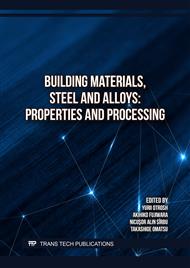[1]
S.S. Dyachenko, I.V. Doshchechkina, A.O. Movlyan, E.I. Pleshakov, Materialoznavstvo: Pidruchnyk, Kharkiv, KHNADU, 2007, 440 s.
Google Scholar
[2]
A.M. Dolzhansʹkyy, O.S. Maksakova, K.O. Chornoivanenko ta in., Tekhnichne rehulyuvannya ta kontrolʹ na pidpryyemstvi: pidruchnyk, Dnipro, Svidler, 2023, 632 s.
Google Scholar
[3]
J.W.D. Callister, D.G. Rethwisch, Materials science and engineering: an introduction. John wiley & sons, 2020.
Google Scholar
[4]
P. Śliwiński, M.S. Węglowski, K. Kwieciński, A. Wieczorek, Electron beam surface hardening. Biuletyn Instytutu Spawalnictwa w Gliwicach, (2022) 66.
DOI: 10.17729/ebis.2022.1/1
Google Scholar
[5]
T. Burakowski, T. Wierzchoń, Inżynieria Powierzchni Metali. Wydawnictwo Naukowo-Techniczne, Warszawa, 1995.
Google Scholar
[6]
L.A. Dobrzański, Materiały inżyniersk- ie i projektowanie materiałowe. Podstawy nauki o materiałach i metaloznawstwo. Wydawnictwo Naukowo-Techniczne, Warszawa, 2006.
Google Scholar
[7]
I. Nowotyńska, S. Kut, Wybrane meto dy obróbki powierzchni narzędzi do for- mowania metali. Logistyka, (2014) 6.
Google Scholar
[8]
L.A. Dobrzański, A.D. Dobrzańska-Danikiewicz, Obróbka powierzchni materiałów inżynierskich. Open Access Library. 5 (2011).
Google Scholar
[9]
A.K. Lakshminarayanan, V. Balasubramanian, Understanding the parameters controlling friction stir welding of AISI 409M ferritic stainless steel. Metals and materials international. 17(6) (2011) 969–981.
DOI: 10.1007/s12540-011-6016-6
Google Scholar
[10]
I. Galvao, R.M. Leal, A. Loureiro, Influence of tool shoulder geometry on properties of friction stir welds thin copper sheets. Journal of materials processing technology. 213(2) (2013) 129–135.
DOI: 10.1016/j.jmatprotec.2012.09.016
Google Scholar
[11]
N. Rajamanickam, V. Balusamy, G. Magudeeswaran, K. Natarajan, Effect of process parameters on thermal history and mechanical properties of friction stir welds. Materials & Design. 30(7) (2009) 2726–2731.
DOI: 10.1016/j.matdes.2008.09.035
Google Scholar
[12]
A. Momeni, H. Arabi, A. Rezaei, H. Badri, S.M. Abbasi, Hot deformation behavior of austenite in HSLA-100 microalloyed steel. Materials Science and Engineering: A. 528 (4–5) (2011) 2158–2163.
DOI: 10.1016/j.msea.2010.11.062
Google Scholar
[13]
H. Sidhom, F. Ghanem, T. Amadou, G. Gonzalez, C. Braham, Effect of electro discharge machining (EDM) on the AISI316L SS white layer microstructure and corrosion resistance. The international journal of advanced manufacturing technology. 65 (1–4) (2013) 141–153.
DOI: 10.1007/s00170-012-4156-6
Google Scholar
[14]
K. Sipos, M. Lopez, M. Trucco, Surface martensite white layer produced by adhesive sliding wear friction in AISI 1065 steel. Revista latinoamericana de metalurgia y materiales. 28 (1) (2008) 46–50.
Google Scholar
[15]
O. Volkov, Z. Kraevska, A. Vasilchenko, T. Hannichenko, Additional strengthening of "screper" jewelry tool using friction. Solid state phenomena. 334 (2022) 100–106.
DOI: 10.4028/p-w6bzqu
Google Scholar
[16]
O. Volkov, V. Subbotinа, Z. Kraievska, A. Vasilchenko, Selection and application of the optimal surface engineering method to restore the properties of rolling equipment elements that have been reduced due to violations of surface grinding technology. Solid state phenomena. 350 (2023) 13–19.
DOI: 10.4028/p-5ctyhi
Google Scholar
[17]
O. Volkov, Z. Kraevska, H. Kulyk, A. Vasilchenko, The Influence of Energy-Force Parameters on the Condition of Surface Structure and Properties of Steel during Frictional Thermomechanical Processing. Solid State Phenomena. 364 (2024) 47–55.
DOI: 10.4028/p-mhxgo5
Google Scholar
[18]
О.А. Volkov, Study of heat deformation influence in surface strain hardening of steel by thermofriction processing. Eastern-European journal of enterprise technologies. 2 5(80) (2016) 38–44.
DOI: 10.15587/1729-4061.2016.65458
Google Scholar


